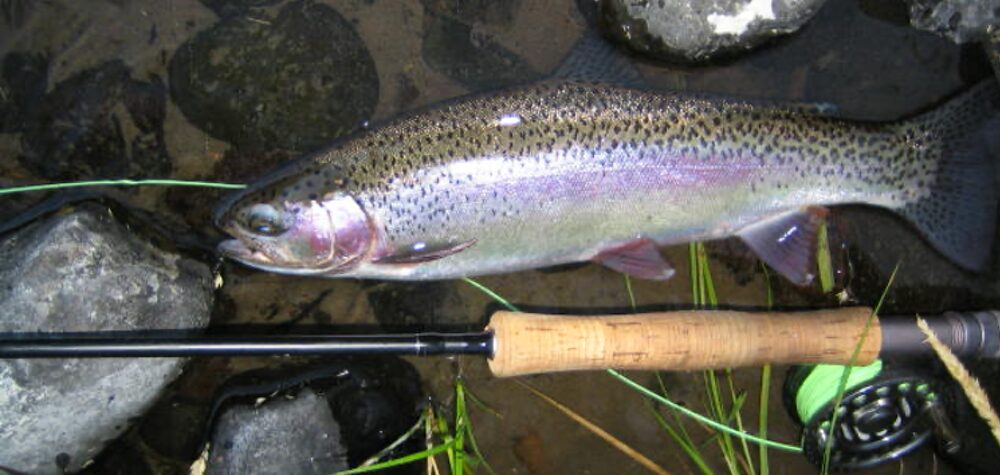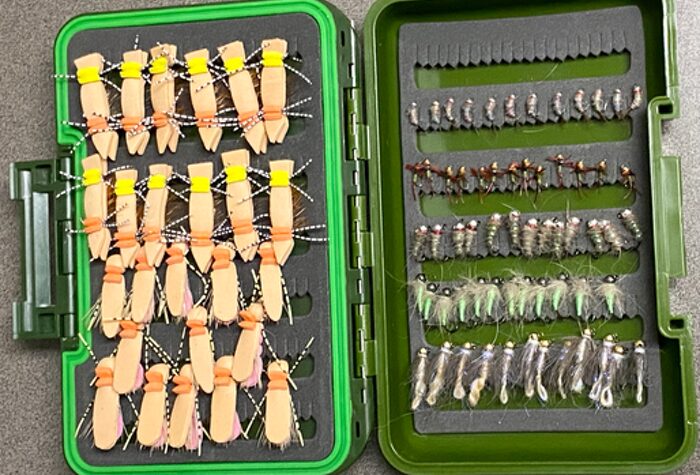What are the top 20 salmonflies for the Lower Deschutes River Oregon? Planning a fishing trip to the Lower Deschutes River in Oregon? If you’re wondering which salmonflies are the most effective, we’ve got you covered. In this blog post, we will delve into the top 20 salmonflies that have proven successful on the Lower Deschutes River.
Salmonflies are incredibly important for fly fishing enthusiasts aiming to catch Native Redband Trout in this scenic river. These large stoneflies, known for their vibrant colors and impressive size, attract the attention of fish and make for an exciting angling experience.
salmon fly life cycle
The life cycle of a salmon fly is a fascinating journey that takes place both underwater and in the air. Understanding the stages of a salmon fly can greatly enhance your fishing experience, especially when it comes to spotting a hatch.
The life cycle of a salmon fly can be divided into four distinct stages: egg, nymph, pupa, and adult.
1. Egg Stage:
The life of a salmon fly begins when the female lays her eggs in the water. These eggs are typically deposited in gravel beds or on the underside of rocks, where they are protected from predators. The eggs remain in this stage for a period of several weeks, depending on water temperature and other environmental factors.
2. Nymph Stage:
After the eggs hatch, the salmon fly enters the nymph stage. Nymphs are aquatic insects that resemble small worms or larvae. During this stage, they spend their time feeding on algae and other small organisms in the water. Nymphs are usually found in the deeper parts of rivers and streams, where they hide among rocks and vegetation.
3. Pupa Stage:
When the nymphs reach maturity, they undergo a dramatic transformation known as the pupa stage. During this phase, the nymphs develop wings and other adult characteristics. Pupae are often referred to as “bubbleheads” due to the small air bubbles they carry with them as they ascend to the water’s surface. Once at the surface, the pupae shed their nymphal exoskeleton and emerge as adult flies.
4. Adult Stage:
The adult salmon flies, often called “dries,” are the stage most anglers are familiar with. These flies have fully-formed wings and are capable of flight. They live for a short period, usually a few weeks, during which their primary goal is to reproduce. Adult salmonflies gather in swarms along the riverbanks, trees, or nearby vegetation. It is during this time that fly fishermen eagerly await the hatch, as the presence of adult flies attracts hungry fish to the surface.
Spotting a hatch while fly fishing can be a thrilling experience. One of the best ways to identify a hatch is by observing the behavior of the fish. When a hatch occurs, you may notice an increase in fish activity near the surface of the water, as they eagerly feed on the emerging flies. Keep an eye out for rising fish, splashes, or disturbances on the water’s surface as these are signs indicating the presence of a hatch.
Additionally, look for the presence of adult flies in the air or on vegetation near the water. The distinct size, shape, and coloration of salmonflies make them relatively easy to spot. Remember to match your fly patterns to mimic the size and color of the hatching flies to increase your chances of success.
Understanding the life cycle of salmonflies and how to spot a hatch can greatly enhance your fly fishing experience. Take the time to familiarize yourself with the different stages and keep a keen eye out for the signs of a hatch. Happy fishing!

Salmon Fly vs Stonefly: Understanding the Differences
Have you ever wondered about the differences between salmonflies and stoneflies? These two types of insects may appear similar at first glance, but they hold distinct characteristics and play different roles in the ecosystem. In this blog post, we will delve into the world of these fascinating creatures and shed light on their unique attributes.
Salmonflies:
– Appearance: Salmon flies typically showcase vibrant colors, such as red, orange, and yellow, making them quite eye-catching. Their body length varies from around 1 to 3 centimeters, with slender bodies and two pairs of transparent wings.
– Lifecycle: These insects belong to the order Diptera and the family Nemestrinidae. Salmon flies undergo a complete metamorphosis, progressing through four distinct stages: egg, larva, pupa, and adult. They lay their eggs near streams or rivers, where the larvae hatch and subsequently develop underwater.
– Habitat and Behavior: Salmon flies are commonly found near water bodies, particularly in regions with abundant aquatic vegetation. They are strong fliers and are often seen hovering near riverbanks or vegetation. Although they do not feed during their adult stage, their larvae are voracious predators, preying on other aquatic insects or small invertebrates.
– Ecological Importance: These insects play a crucial role in the food chain, serving as a valuable food source for fish, birds, and other insectivores. Additionally, their presence can indicate the overall health of the ecosystem, as they are sensitive to changes in water quality.
Stoneflies:
– Appearance: Stoneflies exhibit a distinct appearance, characterized by their stout bodies and membranous wings held flat over their abdomen. They often have a dark brown or black coloration, blending seamlessly with their rocky habitats. In terms of size, stoneflies can range from 1 to 4 centimeters in length.
– Lifecycle: Stoneflies belong to the order Plecoptera, and their lifecycle also consists of distinct stages: egg, nymph, and adult. These insects usually prefer clean, cold, and well-oxygenated water bodies, such as streams or rivers. The nymphs are aquatic and spend a significant portion of their lives in water, feeding on detritus or algae before undergoing a final molt to emerge as adults.
– Habitat and Behavior: Stoneflies are often found near running water and rocky streambeds. They are well-adapted to withstand strong currents and can cling to stones or other submerged objects using their hook-like feet. While stonefly adults possess wings, they are not strong fliers and are mainly active at night. Their primary focus during this stage is reproduction.
– Ecological Importance: Stoneflies are considered indicators of good water quality. Their presence indicates that the habitat is clean and unpolluted, making them crucial in monitoring freshwater ecosystems. Additionally, stonefly nymphs serve as a significant food source for various aquatic organisms, including fish.
In conclusion, while salmon flies and stoneflies may share some resemblances, they are distinct in their appearance, lifecycle, habitat, behavior, and ecological significance. Understanding these differences can deepen our appreciation for the intricate web of life that exists within our ecosystems. As we strive to protect and preserve our natural surroundings, the importance of these remarkable insects cannot be understated.
Remember to stay tuned for more informative content on our website as we explore the wonders of the natural world and delve into captivating topics like the salmon fly vs stonefly debate.
Salmonfly Hatch
The salmonfly hatch is an awe-inspiring natural phenomenon that occurs in rivers and streams across the country. This annual event attracts anglers and nature enthusiasts alike as the waters come alive with the vibrant colors of these magnificent creatures.
During the salmonfly hatch, the riverbanks become a gathering place for a variety of wildlife, including birds, otters, and other fish species. The fish themselves go into a feeding frenzy, creating a prime opportunity for anglers to test their skills and reel in some trophy-worthy catches.
Not only is the salmonfly hatch a spectacle to witness, but it also plays a vital role in the ecosystem. As the salmonflies emerge from the water, they become a significant food source for many animals, helping to sustain the delicate balance of nature.
Whether you’re an avid angler or simply a nature lover, experiencing the salmonfly hatch is an unforgettable experience. So pack your fishing gear, grab your camera, and get ready to immerse yourself in the wonders of this remarkable event. Join us as we explore the beauty and excitement of the salmonfly hatch and uncover its secrets along the way. Follow Salmonfly Hatch for more information.
Nymphs-PMD-Yellow Sallies
We list samlonfly dries in our top twenty, but make sure you bring Stonefly Nymphs, Salmonfly Nymphs, PMD, and Yellow Sallies. These flies are essential for any angler seeking to reel in trophy-worthy catches during the salmonfly hatch.
1. Salmon Fly Nymphs: These nymphs are a must-have in every fly fisherman’s arsenal. With their realistic imitation of the salmonfly nymph, these flies are irresistible to trout. Their large size and vibrant colors make them highly visible in the water, attracting fish from afar.
*Pats Rubber Legs
*Kaufman Stone Rubber Legs
*Get-it-down Pats Rubber Legs
*Candy Stone
*Big Ugly Stone
2. Golden Stonefly Nymphs: Another top choice for fly fishing enthusiasts, golden stonefly nymphs mimic the nymph stage of the golden stonefly. These flies are known for their lifelike appearance and incredible durability, making them effective in all types of water conditions.
*Tungstone
*Brooks Golden Stone
*Iron Sally
*Golden Stone-Poxy-Back
*Psycho-Prince
3. Pale Morning Dun (PMD) Nymphs: When it comes to imitating the PMD, these nymphs are second to none. With their delicate, cream-colored bodies, they perfectly mimic the mayfly nymph stage. These flies are especially effective during the early morning and late afternoon hatches, when PMDs are most active.
*Parachute PMD
*Adams Yellow
*Foam Post Emerger PMD
4. Yellow Sallies: Don’t overlook the importance of yellow sallies in your fly box. These small, yellow-colored stonefly nymphs are a favorite among trout. Their realistic appearance and enticing movement in the water make them irresistible to hungry fish.
*Yellow Sally
*Yellow Sally Foam Emerger
As you embark on your fly fishing journey, make sure to arm yourself with these top five nymphs: salmon fly nymphs, golden stonefly nymphs, PMDs, and yellow sallies. Their realistic imitations and proven effectiveness will increase your chances of landing that prized catch during the salmonfly hatch. So grab your gear and get ready for an unforgettable angling experience.

Top 20 Salmonflies-Lower Deschutes River
1. Kaufmann Stone
2. Norm Woods Special
3. Sofa Pillow
4. Fluttering Stone
5. Chubby Chernobyl
6. Tarantula
7. Morrish Hopper
8. Stimulator
9. Foam Beetle
10. Rubberleg Stimulator
11. Extended Body Salmonfly
12. Sofa Pillow Stone
13. Clark’s Stonefly
14. Rogue Foam Salmonfly
15. Madam X
16. Bullet Head Salmonfly
17. Norm Woods Special Salmonfly
18. Fat Albert
19. Metallic Salmonfly
20. Morrish’s Foamulator
These top 20 salmonflies have been carefully selected based on their proven success rates on the Lower Deschutes River. Whether you’re a seasoned angler or a beginner, these flies are sure to increase your chances of hooking that prized catch.
Remember, always match the size and color of your fly to the prevalent salmonfly species in the area. It’s essential to observe the natural habitat and behavior of these insects for optimal success. Additionally, varying your presentation and technique can greatly improve your results.
Before embarking on your fishing adventure, make sure to check local regulations and obtain the necessary permits. Respect the river and its surroundings, ensuring a sustainable and enjoyable experience for all.
Now that you’re equipped with the knowledge of the top 20 salmonflies for the Lower Deschutes River, it’s time to gear up and get ready for an unforgettable angling experience. Cast your line, enjoy the beauty of Oregon’s scenic river, and let these proven flies increase your chances of success. Happy fishing! Follow Deschutes River Fly Fishing Guides to book your dreamtrip in Central Oregon.

0 Comments